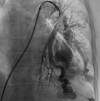Pulmonary arteriovenous malformations in Rendu-Osler-Weber syndrome
- PMID: 38659617
- PMCID: PMC11042540
- DOI: 10.1590/1677-5449.202301332
Pulmonary arteriovenous malformations in Rendu-Osler-Weber syndrome
Abstract
Rendu-Osler-Weber syndrome, also known as hereditary hemorrhagic telangiectasia, is an autosomal dominant hereditary disorder. It is characterized by presence of multiple arteriovenous malformations (AVMs) and telangiectasias. This article reports two cases of patients with Rendu-Osler-Weber syndrome who had pulmonary AVMs and underwent successful endovascular treatment. A brief review of the literature shows that up to 50% of patients with the syndrome have pulmonary AVMs and there is usually a positive family history in these patients. These pulmonary AVMs are multiple in 30% of cases and are associated with the most severe disease complications. Most patients are asymptomatic, even in the presence of AVMs with right-left shunts. When these shunts exceed 25% of the total blood volume, dyspnea, cyanosis, digital clubbing, and extracardiac murmurs may occur. Endovascular treatment is safe and offers control of complications from hereditary hemorrhagic telangiectasia and is currently the treatment of choice for these lesions.
Resumo: A síndrome de Rendu-Osler-Weber, também conhecida como telangiectasia hemorrágica hereditária, é uma doença hereditária autossômica dominante. Ela é caracterizada pela presença de múltiplas malformações arteriovenosas e telangiectasias. Este artigo relata dois casos de pacientes com síndrome de Rendu-Osler-Weber que apresentaram malformações arteriovenosas pulmonares e foram submetidos a tratamento endovascular com sucesso. Uma breve revisão da literatura mostra que até 50% dos pacientes com a síndrome têm malformações arteriovenosas pulmonares e geralmente há um histórico familiar positivo nesses pacientes. Em 30% dos casos, elas são múltiplas e estão associadas a complicações mais graves da doença. A maioria dos pacientes é assintomática, mesmo na presença de malformações arteriovenosas com shunt direito-esquerdo. Quando esses shunts excedem 25% do volume total de sangue, podem surgir dispneia, cianose, baqueteamento digital e sopros extracardíacos. O tratamento endovascular oferece segurança e controle das complicações da telangiectasia hemorrágica hereditária, sendo atualmente o tratamento de escolha para essas lesões.
Keywords: Rendu-Osler-Weber; arteriovenous fistula; embolization, therapeutic; telangiectasia, hereditary hemorrhagic.
Copyright© 2024 The authors.
Conflict of interest statement
Conflicts of interest: No conflicts of interest declared concerning the publication of this article.
Figures






















Similar articles
-
Digital Clubbing in Hereditary Hemorrhagic Telangiectasia/Juvenile Polyposis Syndrome.Acta Dermatovenerol Croat. 2021 Apr;291(1):56-57. Acta Dermatovenerol Croat. 2021. PMID: 34477067
-
[Brain abscess and Osler-Weber-Rendu syndrome: Do not forget to look for pulmonary arteriovenous malformations].Rev Med Interne. 2020 Nov;41(11):776-779. doi: 10.1016/j.revmed.2020.06.009. Epub 2020 Jul 25. Rev Med Interne. 2020. PMID: 32723482 French.
-
[Embolotherapy of recanalized symptomatic pulmonary arteriovenous malformations in a patient with Rendu-Osler-Weber syndrome: a case report and review of literature].Przegl Lek. 2012;69(7):320-5. Przegl Lek. 2012. PMID: 23276025 Review. Polish.
-
Percutaneous embolization of pulmonary arteriovenous malformations in adult patient with Rendu-Osler-Weber: a case report.Eur Heart J Case Rep. 2023 Nov 3;7(11):ytad533. doi: 10.1093/ehjcr/ytad533. eCollection 2023 Nov. Eur Heart J Case Rep. 2023. PMID: 37954570 Free PMC article.
-
Arteriovenous Malformations in the Setting of Osler-Weber-Rendu: What the Radiologist Needs to Know.Curr Probl Diagn Radiol. 2022 May-Jun;51(3):375-391. doi: 10.1067/j.cpradiol.2021.03.009. Epub 2021 Mar 11. Curr Probl Diagn Radiol. 2022. PMID: 33827770 Review.
Cited by
-
Idiopathic pulmonary arteriovenous malformation: a rarity in clinical practice.J Vasc Bras. 2025 Jan 13;23:e20240005. doi: 10.1590/1677-5449.202400052. eCollection 2024. J Vasc Bras. 2025. PMID: 39866168 Free PMC article.
References
-
- Garcia RID, Cecatto SB, Costa KS, Angélico FV, Jr, Uvo IP, Rapoport PB. Síndrome de Rendu-Osler-Weber: tratamento clínico e cirúrgico. Rev Bras Otorrinolaringol. 2003;69(4):577–580. doi: 10.1590/S0034-72992003000400022. - DOI
LinkOut - more resources
Full Text Sources
